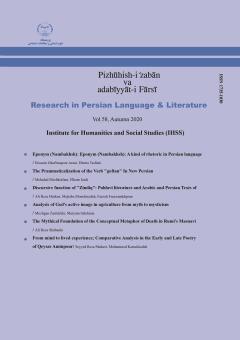Eponym (Nambakhsh): Eponym (Nambakhsh): A kind of rhetoric in Persian language
Subject Areas : Research in Iranian classical literaturehosein ghorbanpoor 1 , elmira taslimi 2 *
1 -
2 - دانشجوی دکتری زبان و ادبیات فارسی، دانشگاه کاشان
Keywords: Eponym, Metaphor, Symbol, Literary genre,
Abstract :
The eponym is a noun and an adjective that has become a concept. In fact, the concept has become one with the object, and nowis used in as aconcept that has been accepted by the collective subconscious.Unlike Metaphor, eponym is not used in literary language; rather it is mostly used in common language; and contrary to metaphor, which requires a symmetrical understanding, eponym is rooted in the unconscious group of a particular people or culture.In fact, eponyms are stereotyped metaphors which understanding them depends on cultural similarity. Such words have been widely used in language; but in Persian, so far no research has been done on this genre. This research seeks to introduce eponym as a genre and also to classify such nouns based on their semantic domain and type of its usage.The method of this research has been qualitative and its data has been done based on descriptive-analytical method and using library study tools. The result of this division is putting eponyms in eight different groups: religious and non-religious, animals and people, positive and negative, politics and place. On the other hand, they have been put in six categories: names of persons, animals, place, accessories related to religious and mythical elders, and in the meanings of virtual worlds and adjective. The most frequent eponyms in Persian are special nouns that have become adjectives such as Iblis and the Antichrist. Some eponyms are animals that have become adjectivessuch as carnivores and hyenas. Some place names have also become adjectives; like Sahrayeh Karbala & Resurrection.
انوری، حسن (1387) فرهنگ سخن، چاپ پنجم، تهران، سخن.
آهنی، غلامحسین (1357) معانی و بیان، تهران، مدرسۀ ادبیات و زبانهای خارجی.
پورنامداریان، تقی (1396) رمز و داستانهای رمزی در ادب فارسی، چاپ نهم، تهران، علمی و فرهنگی.
شفیعی کدکنی، محمدرضا (1390) صور خیال در شعر فارسی، چاپ چهاردهم، تهران، آگه.
شمیسا، سیروس (1372) بیان، چاپ سوم، تهران، مجید و فردوسی.
علوی مقدم، محمد و رضا اشرفزاده (1388) معانی و بیان، چاپ نهم، تهران، سمت.
کزازی، میر جلالالدین (1368) زیباشناسی سخن پارسی بیان، چاپ چهارم، تهران، مرکز.
گوستاو یونگ، کارل (1393) انسان و سمبولهایش، مترجم محمود سلطانیه، چاپ نهم، تهران، جامی.
لیکاف، جورج و مارک جانسون (1397) استعارههایی که با آنها زندگی میکنیم، مترجم جهانشاه میرزابیگی، چاپ دوم، تهران، آگه.
معین، محمد (1371) فرهنگ فارسی، چاپ هشتم، تهران، امیرکبیر.
همایی، جلال الدین (1367) فنون بلاغت و صناعات ادبی، چاپ پنجم، تهران، نیما.
---------------- (1370) یادداشتهای استاد جلالالدین همایی دربارۀ معانی و بیان، به کوشش ماهدخت بانو همایی، تهران، هما.
یاحقی، محمدجعفر (1398) فرهنگ اساطیر، چاپ ششم، تهران، فرهنگ معاصر.
Al Aboud, khalid and Al Aboud (2012) "Eponyms in Dermatology Literature Linked to Japan", Cilinical, Cosmetic & Investigational Dermatology, 5, 15-21.
Al Aboud, khalid and Al Aboud, Ahmad (2013/A) "Eponyms in Dermatology Literature Linked to Genital Skin Disorders", Historical Article, 2, 243-246.
Al Aboud, khalid and Al Aboud, Ahmad (2013/B) "Eponyms in Dermatology Literature Linked to Plantar Keratoderma", Historical Article, 4, 573-578.
Al Aboud, khalid and Al Aboud, Ahmad (2013/C) "Eponyms in Dermatology Literature Linked to Switzerland", Dermatology Eponyms, 4, 121-127.
Budrys, valmantas (2005) "Neurological Eponyms Derived from Literature and Visual Art", Neurology and Art, 53, 171-178.
M.
Fargen, Kyle & L.
Hoh, Brian (2014) "The Debate over Eponyms", Point-Counterpoint, 27, 1137-1140.
PBM, Thomas (2016) "Are medical eponyms really dying out? A study of their usage in the historical biomedical literature", Royal College of Physicians of Edinborg, 46, 295-299.
P.
Wilmot, James (2003) "Malignancy, Thrombosis and Troussean: The Case for an Eponym", Historical Article, 1, 2463-2465.
Oxford www.
Thelancet.
Com (april, 2006, 1296, number 22)

